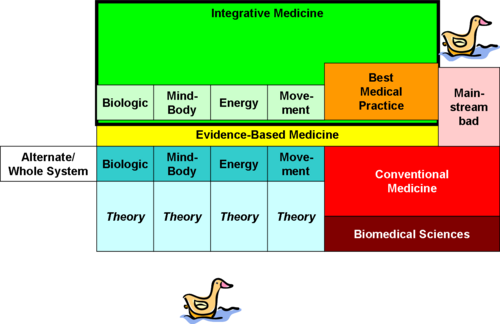Talk:Archive:Healing Arts Workgroup
(Porting this over as a start) Maybe a picture will help. On the right, you have (red) medicine, with a theoretical underpinning of biomedical sciences. Some of conventional medicine makes it through the filter of evidence-based medicine, and combines into orange: the best common practice of standalone conventional medicine. Some of conventional medicine doesn't have supporting evidence and as much quackery as the wildest alt theory.
Now, to the left, you have five boxes, not the neatest grouping but based on the NCCAM taxonomy. Alternative or whole systems, by definition, deal with all the healthcare needs of an individual and don't want to work with any other discipline. Perhaps the least controversial example would be a form of spiritual therapy that wants absolutely nothing but prayer, or sacrificing goats, or whatever. By its very definition, alternative medicine is alternative to everything else, and isn't going to be complementary or integrative.
To the right, there are four boxes of categories of technique. Now, there's no good way to draw something I'll explain: a given technique may be used in alternate medicine, or it might be used in complementary medicine. Complementary means "willing to play nicely with other disciplines".
Some blue complementary theories make it through the EBM filter and become light green. Bright green Integrative medicine is the combination of complementary and mainstream techniques, working together, which all meet varying standards for evidence-based medicine.
Each technique has verying levels of theory. Just like some conventional medicine doesn't make it through EBM and is quackery, some of the CAM techniques drop down and go quack-quack too.
My suspicion is that there's no one plausible theory article for CAM, any more than there's really common theory between the mechanical requirements of a replacement hip joint and the biochemical treatment of schizophrenia. The four types of CAM, to some extent, do have some commonality, although the assumptions of one energy technique, such as acupuncture , are very different from those of reflexology, and the specific discipline theory will be in the discipline-specific article.
There are cases where a given type of practitioner uses more than one class. For example, Traditional Chinese Medicine practioners use, among other things, herbals and acupuncture.
The team approach in integrated medicine can use all of the EBM-approved techiques. For some complementary techniques, the level of risk is so low, they don't interfere with other techniques, and are cheap enough that they don't need the same level of evidence as something more dangerous/interfering/costly. Howard C. Berkowitz 23:45, 29 December 2008 (UTC)
- Is this nice picture to help us here at talk or are you proposing some version of it for the article? If the latter, I would say emphatically NO. It's not intuitive, and, I would say, it's almost certainly Original Research.... (If it takes 500 words to explain a diagram, then it's not worth using. Hayford Peirce 01:39, 30 December 2008 (UTC)
- For Talk, specifically addressed to Larry's questions about how articles fit together. I would put it as a challenge to anyone thinks there is a meaningful single theory of alt med: where does it go, given all these other pieces are reasonably well defined? What theory, for example, would be common to reflexology, acupuncture, reiki, and therapeutic touch, beyond a generic "they all involve energy". Howard C. Berkowitz 02:00, 30 December 2008 (UTC)
- Though arguments could be made concerning the locations and sizes of the boxes, the jist of diagram is pretty close; that Howard shows a good understanding of the problem, which is halfway to the solution. Why don't we consider bringing this to the workgroup page where we can document the process and at the same time develop the plan for all the Healing Arts articles, not just this one. Then maybe this one will fall into place. D. Matt Innis 02:04, 30 December 2008 (UTC)
- Don't read anything into the size of the boxes -- some are that way just because it was a quick way to get the necessary text into the boxes without changing fonts, or to have certain color changes (i.e., blue passing through yellow becomes green, red passing through yellow becomes orange). And yes, green and orange, as I think of it, should have been brown. I'll be happy to take comments and fix it up, but that was 15 minutes of PowerPoint, not a more powerful graphics package or hand-drawn and scanned.
- Having a workgroup discussion is a great idea. Some of you may know this, but the first chapter of each monograph I've written has the same title: "what problem are you trying to solve.". Matt, have you an idea on how to start this? I have been trying to get simple definitions of the alt disciplines, many just stubs. I am fairly happy with integrative medicine, but if there's a better way, I won't lose sleep. If I lose weight, tell me more. :-)
- Matt, do you want a copy of the PowerPoint original? Howard C. Berkowitz 02:45, 30 December 2008 (UTC)
